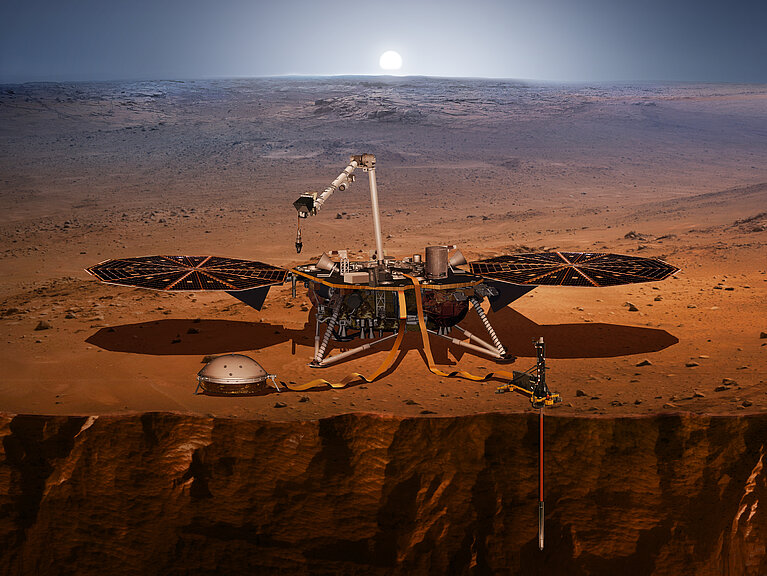May 25, 2018 - by Simone Ulmer
On 5 May, the NASA “InSight”-lander set off on its journey to Mars. This is the first mission dedicated to investigate the internal structure of the red planet and to answer some key questions such as: Why have Earth and Mars developed so differently although their original structure and chemical composition seem so similar? How large, thick and dense are the core, mantle and crust? What is their structure? The scientists are hoping to gain fundamental insights into the general formation of rocky planets such as Mars, Earth, Mercury and Venus.
Seismometer for extreme conditions
The lander is equipped with geophysical instruments, in particular a special seismometer; after the landing at the end of November 2018, this device will record seismic vibrations and transfer the data back to Earth.
Researchers from ETH Zurich and the Swiss Seismological Service, who were involved in developing the seismometer’s electronics (see ETH News from 5 May 2018), will be among the first to analyse and interpret the data.
Scientists from the Institute of Geophysics have already started to prepare these analyses. On the “Piz Daint” supercomputer at the Swiss National Supercomputing Centre (CSCS), the researchers calculated seismic wave propagation for around 30 different Mars models.
For their model catalogue, the researchers consolidated all available knowledge about the planet and used this to calculate synthetic seismic data as might be received from Mars. The scientists then used this data to conduct a blind test, in which they published the data and invited experts from around the world to interpret it in order to exchange knowledge and experience in this area.
Universal code for simulating waves
To investigate the influence of the 3D structure of the Mars crust in more detail, Martin van Driel, Senior Researcher at ETH Zurich, simulated seismic waves on Mars with Salvus, a code that he developed at ETH together with his colleagues Michael Afanasiev, Lion Krischer and Christian Böhm. This code is flexible and can be used universally for questions regarding wave propagation in different media on various scales.
The Mars simulations run on “Piz Daint” in real time on 7,200 computing cores – which means the calculations take about as long as the seismic waves need to travel through Mars. Depending on the planet’s internal structure, the waves travel at different speeds and take different routes from the source to the seismometer. The time it takes for the waves to travel through Mars’ interior will help the scientists to better understand the planet’s structure and rock properties.
With around 10 billion degrees of freedom and 300,000 time steps, the scientists managed to solve a considerably large problem. “Without a supercomputer like “Piz Daint”, simulating a single model on a laptop would have taken more than two years – so about four times as long as the lander’s journey to Mars,” says Böhm.
Visualisation at mission launch
The researchers visualised one of the numeric simulations in a video. This was shown at the NASA press conference for the Mars mission rocket launch. The visualisation shows how the waves travel along the surface of Mars, orbiting around the planet and passing the lander three times. Van Driel explains that it is essential to measure the waves on each of the three passes, as this will allow the scientists to gather information about the planet, identify the timing and location of the Mars quake, and to calculate its approximate structure, all with just one seismic station. However, the amplitude of the third wave is smaller by a factor of ten; the seismometer must thus be sensitive and sophisticated enough to measure this and the quake must have a magnitude of at least 4.5.
On Earth, quakes of this magnitude are primarily generated by plate tectonic processes in which continental or oceanic plates collide or slip past each other. Scientists currently believe that plate tectonics is not active on Mars. However, over the course of the two years they expect that meteorite impacts or contractions caused by Mars’ cooling will produce seismic events that are strong enough to be observed by the seismometer.
Prior simulations enable data evaluation
As seismic waves on Mars have never been recorded with such a sensitive seismometer, numerical simulations are the only way to prepare for the data evaluation of the NASA InSight mission.
“We are using the calculated models to check how certain structures, such as the crustal thickness, influence the measurements,” says Böhm. The models thus help the researchers to verify their methods and to better understand seismograms on Mars. Although the seismic data generated by the models appear similar to terrestrial data on first glance, the subtle differences are important. The scientists must therefore familiarise themselves with this new data and learn to interpret it.
In order to finally understand the Martian structure, the ETH researchers will compare the actual measurements with the simulated data. For this, they will draw on the Mars model catalogue to see if and how the measurement changes, taking into account the models, what the structures are and what all the simulations have in common.
Further Information:
Bozdag E et al.: Simulations of Seismic Wave Propagation on Mars, Space Time Reviews (2017), DOI 10.1007/s11214-017-0350-z.
Clinton JF et al.: Preparing for InSight: An Invitation to Participate in a Blind Test for Martian Seismicity, Seimological Research Letters (2017), 88, 1290-1302, DOI: 10.1785/0220170094
